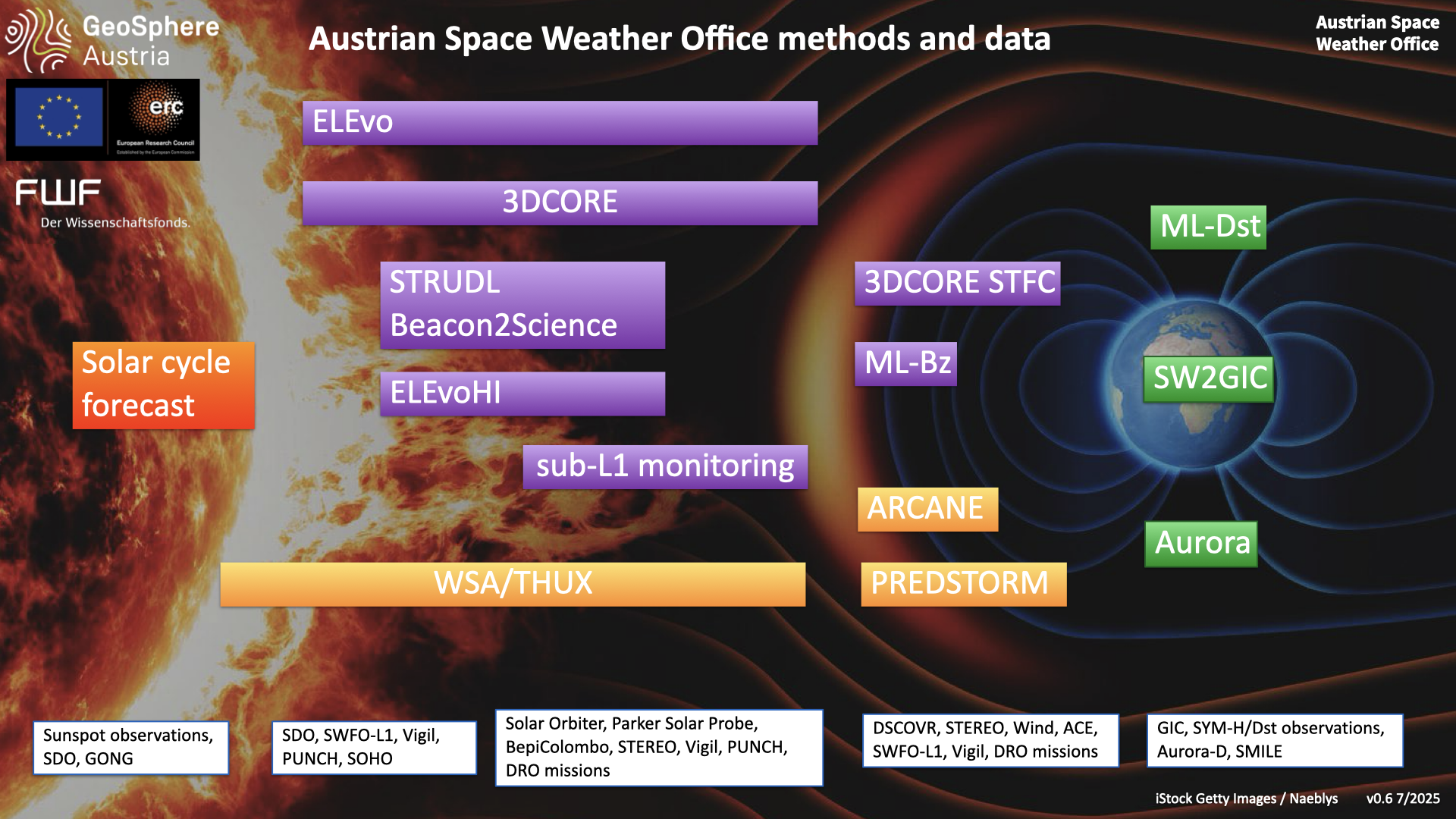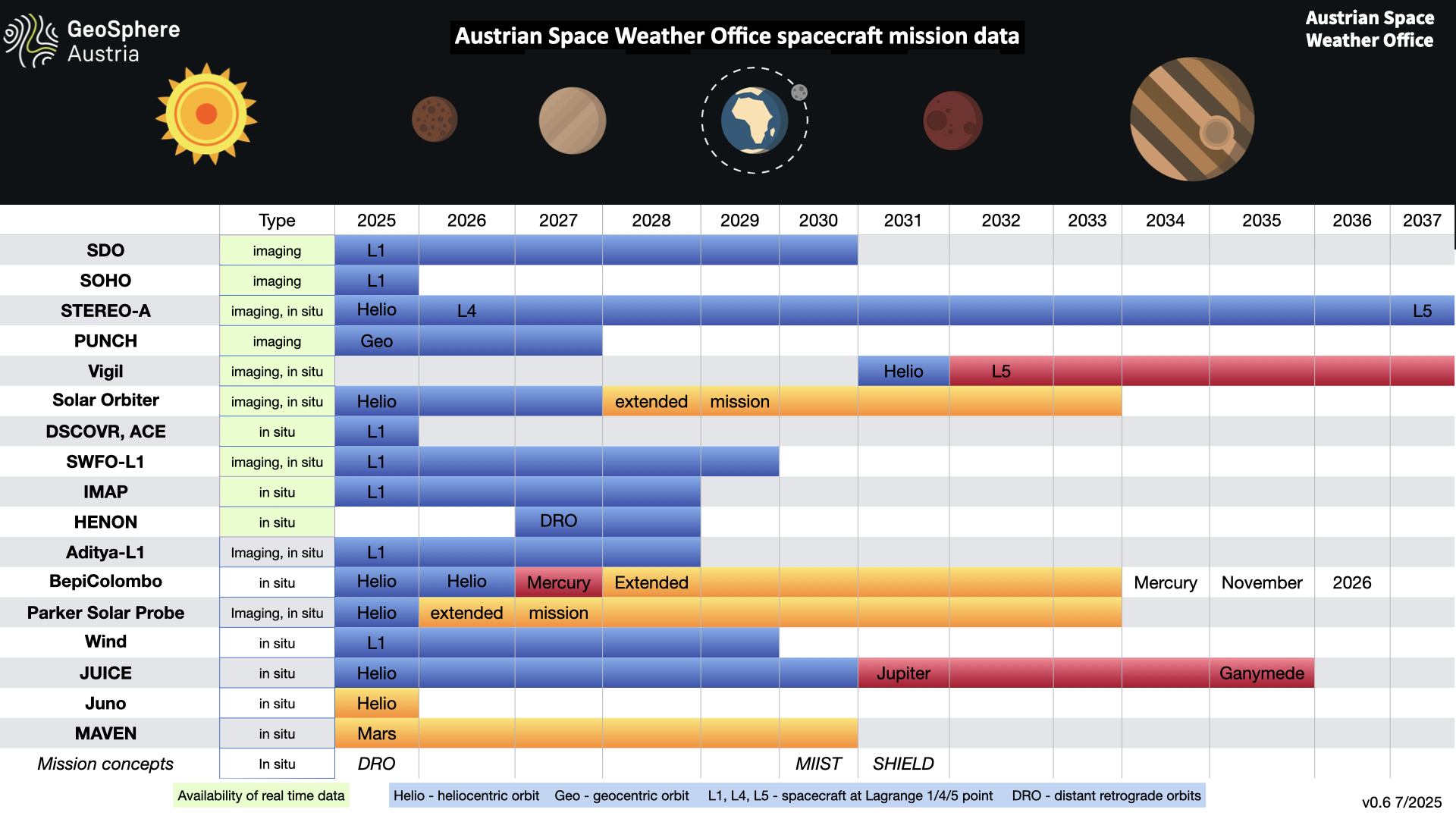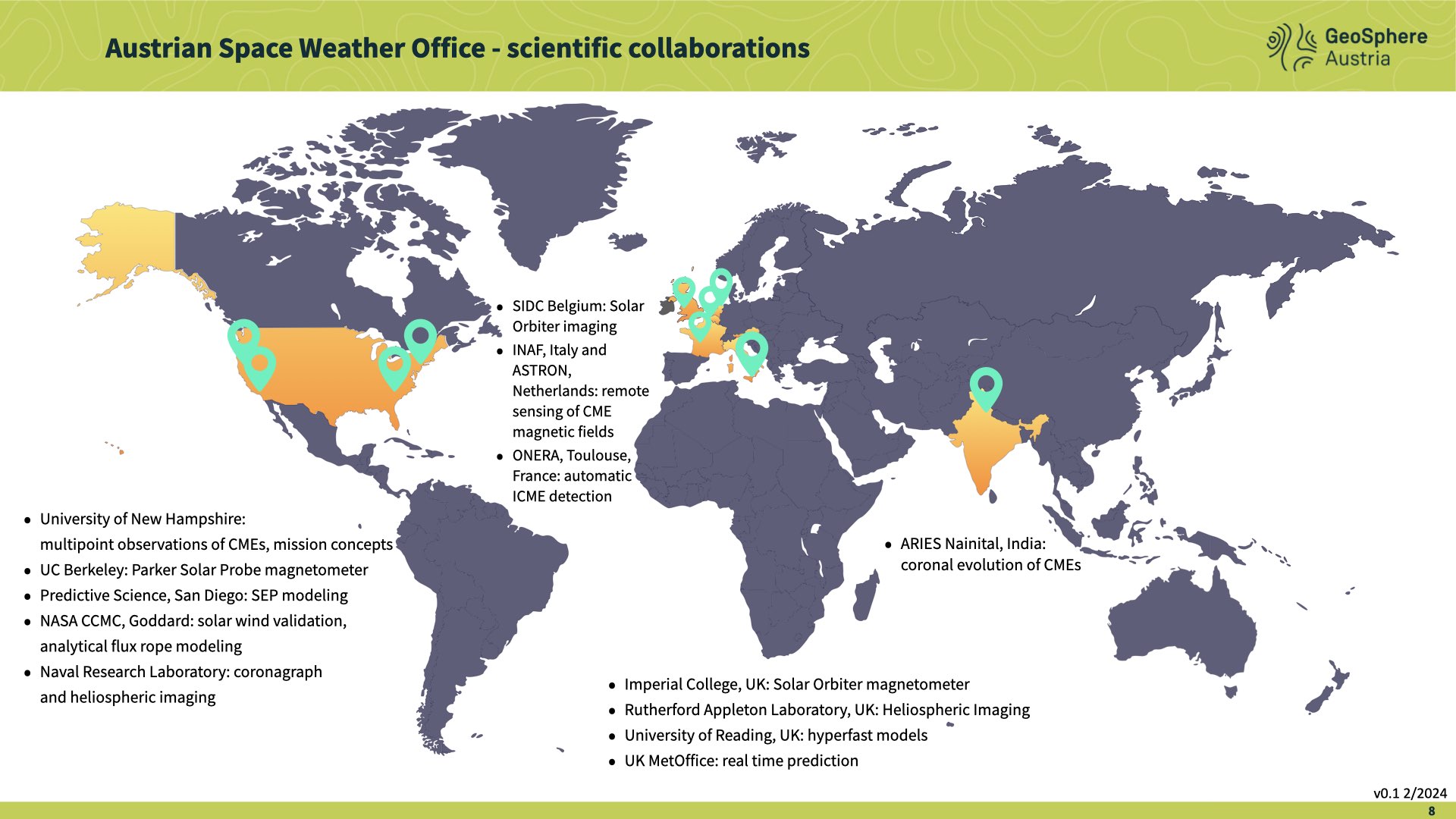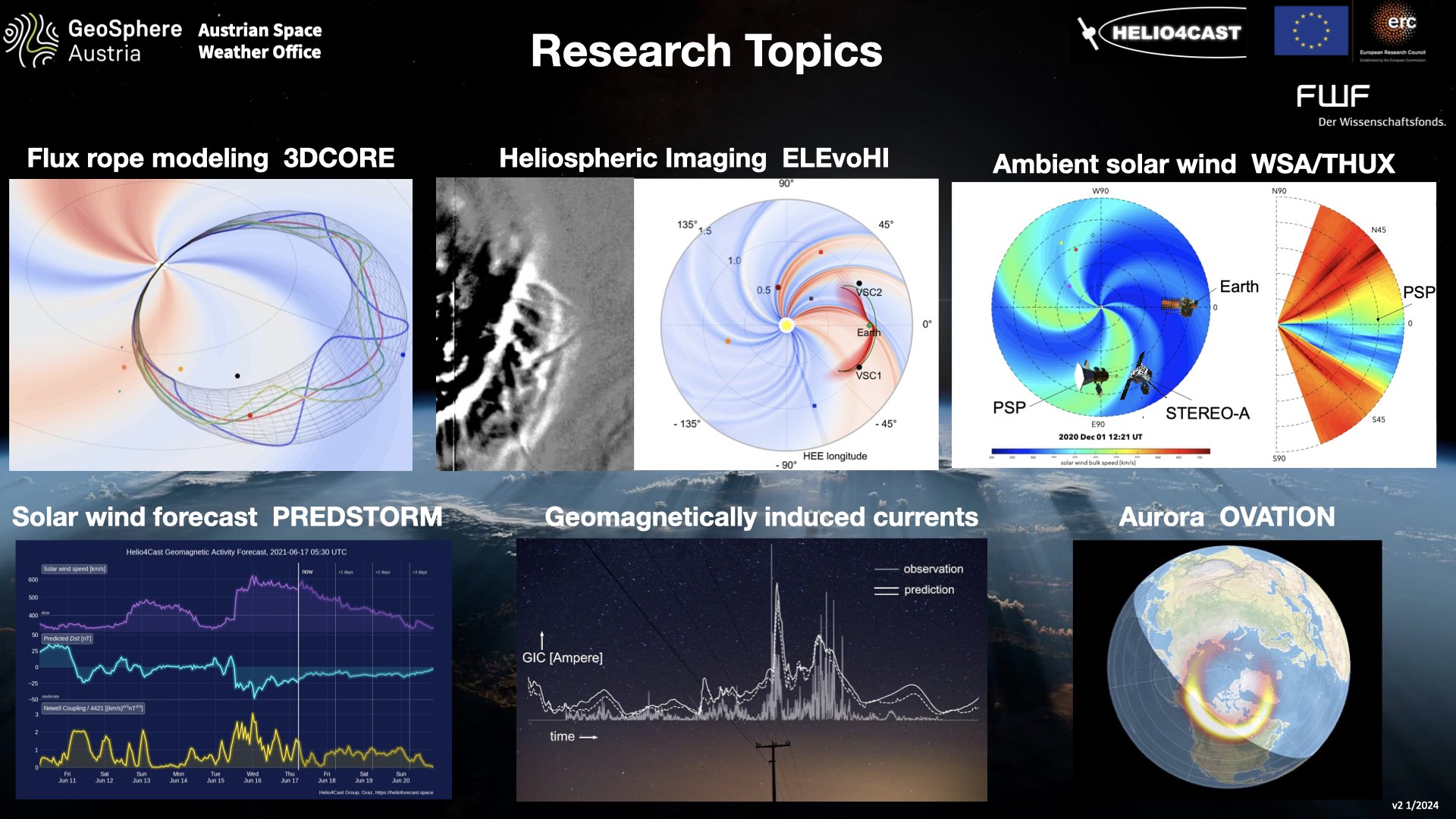Research Topics
Magnetic structure of Coronal Mass Ejections (CMEs)
We are developing 3DCORE, a hyperfast semi-empirical model for flux ropes
in coronal mass ejections that can be used for both fitting and forward modeling of multipoint
in situ signatures of CME flux ropes. We also work on synthetic model images for comparison
to data returned by coronagraphs and heliospheric imagers.
[Möstl+ 2020]
[Weiss+ 2021a]
[Davies+ 2021]
[Weiss+ 2021b]
[Forstner+ 2021]
[Palmerio+ 2021]
[Möstl+ 2022]
[Weiss+ 2022]
[Davies+ 2023]
[Davies+ 2024]
[Weiss+ 2024]
[Rüdisser+ 2024]
Missions: Wind, DSCOVR, STEREO, BepiColombo, Parker Solar Probe, Solar Orbiter, PUNCH, Venus Express, MESSENGER, MAVEN. Future: SWFO-L1, Vigil, Missions on distant retrograde orbits (DRO).
Heliospheric Imaging
We advance innovative methods to use imaging of the solar wind to better predict the arrival time and speed of CMEs at Earth and other planets.
Our ELEvoHI model is the state of the art method in fitting time-elongation tracks of CMEs to model their interplanetary evolution.
We are working on enhancing real time heliospheric imaging data and automatic detection of CMEs with AI methods.
[Amerstorfer+ 2018]
[Barnes+ 2020]
[Amerstorfer+ 2021]
[Hinterreiter+ 2021a]
[Bauer+ 2021]
[Hinterreiter+ 2021b]
[Barnard+ 2022]
[Harrison+ 2023]
[Le Louëdec+ 2025]
Missions: STEREO (SECCHI), Solar Orbiter (SolOHI), Parker Solar Probe (WISPR), PUNCH. Future: SWFO-L1, Vigil.
Solar wind modeling
In collaboration with NASA CCMC, another hyperfast modeling approach, the Wang-Sheeley-Arge (WSA) / Tunable Heliospheric Upwind eXtrapolation (THUX) model is developed
in order to provide ambient solar wind solutions. We employ WSA/THUX for modeling corotating interaction regions (CIRs) and as the ambient wind feeding into our CME evolution models.
With WSA/THUX we investigate open physics questions, for example how coronal holes are connected to CIR properties, or the propagation of uncertainties in the solar initial conditions to 1 AU.
[Reiss+ 2019]
[Reiss+ 2020]
[Reiss+ 2021a]
[Reiss+ 2023]
[Majumdar+ 2025]
Missions: Wind, DSCOVR, STEREO, Parker Solar Probe, Solar Orbiter. Future: SWFO-L1, Vigil, Missions on distant retrograde orbits (DRO).
Real time solar wind prediction
A major unsolved problem in space weather forecasting concerns the prediction of the southward pointing magnetic fields in
CMEs and CIRs that lead to geomagnetic storms, known as the Bz problem. We conduct research into how solar wind data provided by spacecraft at the Sun-Earth L1 point, can be used for permanently updating the solar wind models to provide a feasible solution to the Bz problem. We additionally provide forecasts of Dst, GIC, Newell coupling and aurora based on those solar wind predictions, to understand how the errors
in the solar wind forecasts propagate into geospace. We also use advanced verification methods and AI methods to optimize the physical modeling and to detect ICMEs automatically. A focus is also given to the feasibility of sub-L1 monitors, on distant retrograde orbits, which have been recently testable for the first time with data from STEREO-A and Solar Orbiter.
[Bailey+ 2020]
[Bailey+ 2021]
[Reiss+ 2021b]
[Rüdisser+ 2022]
[Riley, Reiss, Möstl 2023]
[Laker+ 2024]
[Weiler+ 2025]
[Rüdisser+ 2025]
Missions: DSCOVR, Wind, STEREO. Future: SWFO-L1, Vigil, Missions on distant retrograde orbits (DRO).
Geomagnetically induced currents (GICs)
In collaboration with the Conrad Observatory at the GeoSphere Austria and the Technical University
Graz we work on the prediction of GICs in the Austrian power grid. GICs have long been known to affect power grids,
transformers and any earthed conductive networks spanning large distances. We use machine learning approaches to map L1 solar wind nowcasts and forecasts to GICs.
[Bailey+ 2018]
[Bailey+ 2022]
Missions: DSCOVR, Wind, STEREO. Future: SWFO-L1, Vigil, Missions on distant retrograde orbits (DRO).
Exoplanetary space weather
The Solar System is the only stellar and planetary environment in which we can study how stellar eruptions influence various types of planetary atmospheres in great detail. These results can be used as proxies for other stars and their exoplanets. We have provided general parameters of solar eruptions for atmospheric loss modeling of Hot Jupiters.
[Bisikalo+ 2018a]
[Bisikalo+ 2018b]
[Cherenkov+ 2019]
Please see
the publications page for all team publications since 2018.
Our research is covered frequently by national and international media:
[Wie stehen 2026 die Chancen auf Nordlichter?]
[Astrophysiker: "Oft kommt die Frage nach Außerirdischen"]
[ORF: Polarlichter erhellen Himmel über Österreich]
[derStandard: Mächtige Sonnenstürme sorgen für Nordlicht-Spektakel über Österreich]
[Podcast: Mehr als Wind und Wetter - Die stürmische Seite der Sonne]
[New Scientist: Spacecraft used to forecast solar storm 15 hours before it hit Earth ]
[NASA: NASA Missions Help Explain, Predict Severity of Solar Storms]
[TV ORF2: Grazer entwickelten KI für Sonnenstürme]
[Radio Ö1: KI aus Graz für Sonnensturm-Analyse]
[Podcast derStandard: Rätsel der Wissenschaft]
[Polarlichter lassen Österreichs Himmel leuchten]
[Auch 2025 gute Chancen auf Polarlichter in Österreich]
[Starker Sonnensturm sorgte erneut für beeindruckende Nordlichter]
[Missed seeing the northern lights near you? The biggest storm may be yet to come]
[Tanja Amerstorfer: Forecasting Space Weather]
[Seit über 20 Jahren gab es nicht mehr so viele Sonnenflecken]
[Wie nah brachten uns die Sonnenstürme an einen Blackout?]
[Vorerst kaum Chance auf weitere Polarlichter]
[Extremer Sonnensturm könnte Samstagnacht erneut Polarlichter über Österreich bringen]
[Einmal Welt retten, bitte]
[Wie kann man Polarlichter vorhersagen?]
[Polarlichter über Österreich zu sehen]
[Sturmwarnung aus dem Weltall]
[Forschung gegen den globalen Blackout: Das Austrian Space Weather Office]
[Starker Sonnensturm fegte über die Erde]
[Starker Sonnensturm sorgte für Polarlichter auch über Österreich]
[Stärkster geomagnetischer Sturm seit Jahren]
[Stärkster geomagnetischer Sturm seit Jahren sorgte für beeindruckende Nordlichter]
[Grazer Station für das Weltraumwetter]
[AGU Eos: 11 Discoveries Awaiting Us at Solar Max]
[ESA: The Sun as you’ve never seen it before - tracking space weather]
[Warum gibt es gerade so viele Sonnenstürme?]
[Using AI to Predict the Danger of Solar Storms for Earth]
[Sonnenstürme: EU-Förderung für Grazer Forscher]
[2 Millionen Euro gehen an Grazer für Erforschung von Sonnenstürmen]
[ERC-Grants gehen an zehn in Österreich tätige Forschende]
[Podcast: Science Call: Wie Sonnenstürme Satelliten zerstören können]
[Wie gefährliche Sonnenstürme frühzeitig erkannt werden können]
[Künstliche Intelligenz prognostiziert die Gefahr von Sonnenstürmen für die Erde]
[How a rather mundane space storm knocked out 40 SpaceX satellites]
[Der Sonnensturm, der 40 Satelliten vom Himmel holte]
[Wie man die Intensität des Sonnenwindes misst]
[Grazer Frühwarnsystem für Sonnenstürme]
[Sonnenstürme: Künstliche Intelligenz soll Prognose verbessern]
[Weltraumwetter gibt Rätsel auf]
[Die Geheimnisse der Sonne]
[Forscher rechnen mit mehr Sonnenstürmen]
[Wie sich ein katastrophaler Asteroideneinschlag abwenden ließe]
[Planetenkiller: warum Asteroiden hauptsächlich im Film einschlagen]
[Prognose: Bis zu fünf Sonnenstürme könnten pro Monat die Erde treffen]
[Wie man in den nächsten Jahren auf außerirdisches Leben stoßen könnte]
[Wenn die Sonne den Strom abdreht]




